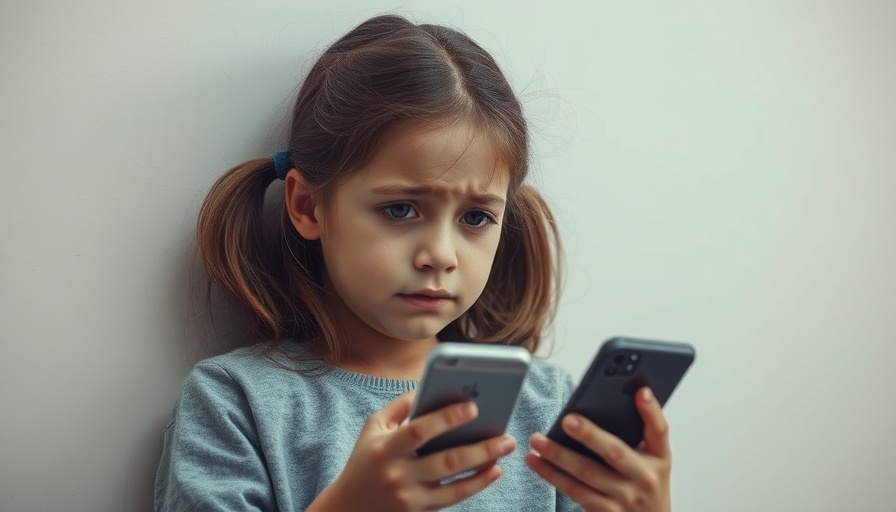
Understanding Cyberbullying: What Parents Need to Know
As digital natives, children today navigate a complex cyber landscape that includes social media, online gaming, and instant messaging. All these platforms can become avenues for cyberbullying, creating silent struggles for many kids. Parents often hope that their children would approach them regarding online mistreatment, yet many youngsters are reluctant to share their experiences. Understanding how children conceal cyberbullying can empower parents to take proactive steps in protecting their children from harm.
1. The Art of Erasure: Deleting Evidence
One of the first steps children often take to hide cyberbullying is deleting harmful messages before any adults, especially parents, can see them. This behavior not only erases potential proof but also denies the kids a record to refer back to if the bullying escalates. It's crucial for parents to foster an open dialogue about online harassment and to assure their children that reporting such behavior will not end in punishment.
2. Secret Online Personas: The Rise of Hidden Accounts
Another tactic employed by children is creating secret accounts on popular platforms like TikTok, Instagram, or Snapchat. These hidden profiles often serve as a shield for bullying behavior that may not be visible to parents who monitor only the main accounts. Parents should engage in meaningful conversations about online safety and the importance of account transparency, helping children understand the risks associated with secrecy.
3. Silencing Notifications: A False Sense of Privacy
Turning off notifications for certain conversations or apps is a common method children use to hide online harassment. This tactic can lead to a façade of normalcy in front of parents, allowing bullying to persist unmonitored. Regular conversations about online activities and discomforts can unveil potential issues that a simple glance at notification settings may miss.
4. Private Browsing: Tools for Concealment
With the availability of private browsing features and hidden apps, children can easily mask conversations or websites where they may be facing bullying. This isolation can reinforce feelings of solitude and despair, making interventions less likely. Parents should educate their children about these tools, emphasizing the importance of not sacrificing openness for privacy.
5. Behavioral Red Flags: Changes in Device Use
Some children actively change their device usage patterns, reducing screen time in front of parents to avoid drawing suspicion. Increased device use in isolated areas like their rooms or bathrooms can indicate they are either hiding something or managing their online interactions with undue stress. Parents should observe not just how much time their children spend online, but when and where they're engaging with digital devices.
6. Humor as a Shield: The “It Was Just a Joke” Defense
Kids often downplay cyberbullying by framing it as humor, saying that messages or comments were merely jokes. This strategy can minimize the seriousness of harmful words, convincing parents to overlook the underlying issues. It’s essential for parents to recognize jokes that cross lines and set guidelines for acceptable communication.
7. Social Connection: The Emotional Impact of Cyberbullying
Understanding the emotional toll that cyberbullying takes on children is vital. Victims may experience increased anxiety, depression, and social withdrawal. Engaging in open discussions about feelings and ensuring a safe space for children to express their fears is key to preventing the escalation of cyberbullying. Encourage children to speak out and make it clear that they are not alone in their struggles.
8. Seeking Help: Resources for Parents and Children
When parents identify signs of cyberbullying or their child opens up about online harassment, seeking external support is vital. Many organizations offer resources, counseling services, and strategies for coping with and addressing cyberbullying effectively. By utilizing available resources, parents can help their children navigate the complexities of online violence.
As our children engage more with digital platforms, the importance of recognizing the signs of cyberbullying becomes imperative for parents. Mapping the landscape of cyberbullying begins at home with open lines of communication, education about online safety, and validating children’s experiences. By taking these proactive steps, parents can create a more supportive environment where children feel safe discussing their online interactions.
To protect your child from the hidden dangers of cyberbullying, take the first step today: have an in-depth conversation with them about their online experiences and establish trust. Understand what’s happening in their online world and empower them to speak out if they ever feel uncomfortable or afraid.
 Add Row
Add Row  Add
Add 




Write A Comment